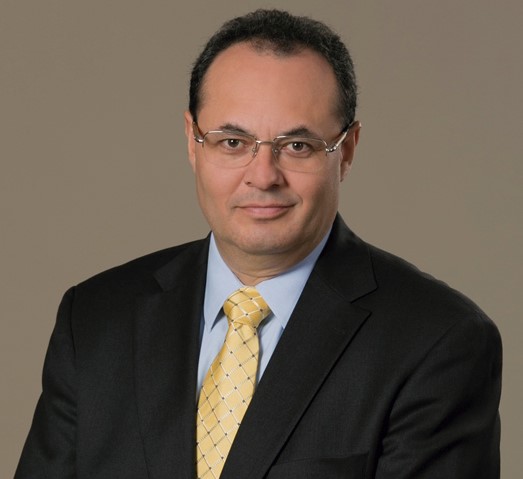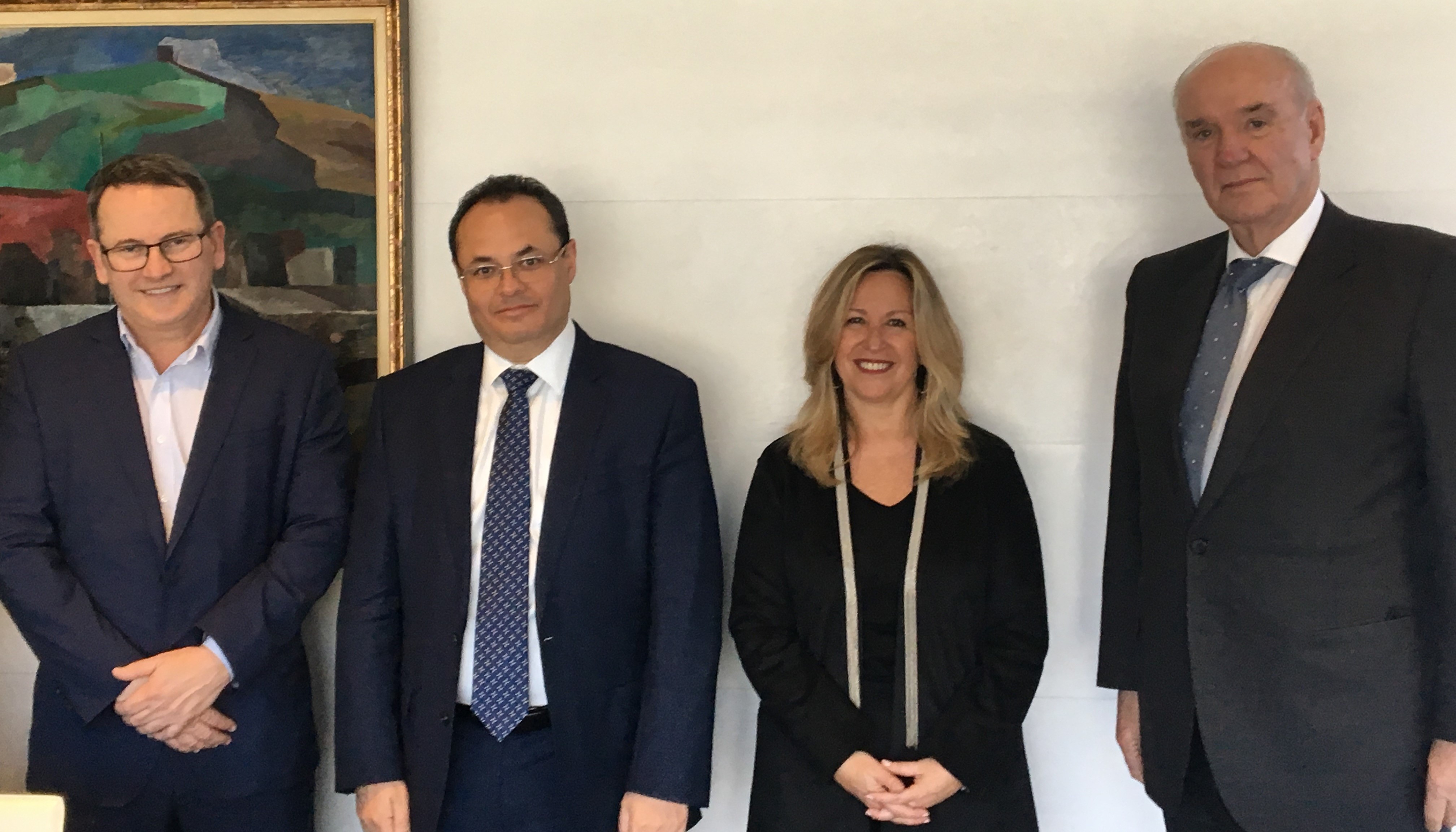
Among the countless trips made by Luis Carranza (Lima, 1966), Chairman of the CAF (Development Bank of Latin America), he reserved a space in his busy schedule to visit Telefónica. The reason for his trip is the celebration of the progress made through the Internet For All programme. Since CAF, Telefónica and Facebook joined together in 2017 to develop this initiative, the commitment of the Lima native to promote the digitisation of Latin America has not ceased. Carranza, with extensive experience in the public and private sectors, shares his vision on how to close the digital divide in Latin America, what is the role of technology in the promotion of the productivity of the region and what reforms are required to successfully implement these needs.
Connectivity and Internet for All
Question: More than half of the world’s population has no Internet access[1]. In the case of Latin America and the Caribbean, 288 million people are not connected to the network, and just four in every ten households have fixed broadband connection[2]. How can we improve this situation to connect all Latin Americans? What role do public and private sectors play in achieving this goal?
Answer: The closing of the digital divide in Latin America and the Caribbean represents a structural challenge that requires aggressive initiatives by the public and private sectors in three areas.
Firstly, it is vital to increase investment in telecommunications infrastructure, especially in rural and urban centres where the low-income population is concentrated. The challenge is greater if we take into account that investment per capita in Latin America is half of that made by the OECD countries, which also explains a significant lag in the expansion of digital technologies such as fibre optics and next-generation networks in mobile communications.
In the case of fibre optics, for example, this technology represents only 6% of the broadband lines in the region. In this sense, the key is to rethink the role of Universal Service Funds in the ICT sector to leverage the public investment under APP schemes, as well as the design of new models from the private sector adapted to the rural reality and marginal costs of extending coverage.
New initiatives for rural connectivity, as developed under the Internet For All (IFA) model in Peru, where an alliance between the private sector (Telefónica, Facebook) and multilateral banking (IDB, CAF), supported by a favourable regulatory environment, will allow mobile internet networks to be extended to nearly 4,000 populated areas of the country and benefit more than 8 million people. Secondly, governments and companies in the industry face the challenge of affordability of broadband services baskets, which can represent on average between 12% and 32% of the income of households in the region[3].
It is important, then, to promote universal service plans focused on the provision of connectivity in isolated areas from the public sector, as well as to rethink digital agendas in terms of subsidies for low-income populations, the acquisition of smartphones and digital literacy plans. From the private sector the migration to flexible offers, adapted to the reality of low-income households and users to models will be fundamental.

In third place, and linked to the previous points, we must promote content, applications and digital services that open interesting opportunities for financial inclusion, access to health, education, e-government and banking services. These services can encourage a greater scale and use of connectivity to the internet by the beneficiaries. So that the productive sector, consumers, governments and public institutions have access to these services, a last mile distribution network is required, but also promoting the development of applications and relevant content that promote demand.
Advances in platforms such as e-commerce, e-government and telemedicine tend to influence the adoption of the Internet. Countries advanced in terms of Internet use which at the same time do not show an important development in applications and local content are scarce. This is why the challenge in terms of public policy to promote the digitisation of households should not only focus on factors related to infrastructure and connectivity, but encourage simultaneously conditions favouring development and penetration of applications.
Productivity and digitisation
Q.: Do you believe that digitisation of production processes and adoption of advanced digital technologies, involved in the Fourth Industrial Revolution, contribute to productivity growth in Latin America?
A.: That’s right. ICTs are no longer just an isolated sector, but rather they begin to affect a wide range of social activities and production processes. While digitisation of consumption is an important aspect for economic development, in the long term it is necessary to improve the levels of total factor productivity allowing sustained growth, thus increasing economic complexity. One of the first studies developed on the digital economy in the region[4], with the participation of the CAF and the Telefónica Foundation, as well as Eclac and cet.la’s, demonstrated that impact of ICT capital in labour productivity was positive in all countries of the region. In sectoral terms, the impact of ICT capital in the financial sector in Argentina, Chile and Mexico, and in Brazil’s and Colombia’s mining was highlighted.
Thus, the incorporation of technologies to increase the productivity of the companies must be one of the focal points of public policies. For this reason, the monitoring we have made within the framework of the CAF’s Observatory of the Digital Ecosystem reveals the magnitude of the challenge we face in terms of technology assimilation in production processes. The region has a production digitisation index 24% lower than the OECD’s.
It is essential in this context, to move forward in the digitalisation of the productive processes supported by broadband networks and virtual systems, such as the Internet of Things, intelligent systems, cloud platforms, Big Data, or Analytics, among others, to modernise and transform the manufacture, operation and distribution processes.
These infrastructures are critical regarding applications that contribute to the digitisation of production processes and precision agriculture, energy distribution, transport and logistics, manufacturing, among others, facilitating production linkages and integration into global value chains.
Although in many cases it is the private sector the one leading the deployment of Internet of Things networks, public policies have an important role in areas such as technical standards to ensure the interoperability of devices and networks, cybersecurity, stimulating innovation in the development of equipment and applications, as well as the costs of access to the spectrum, as IoT applications demand high volumes of capacity on networks.
From the CAF, with the participation of Eclac, ASIET, Telefónica and the Ibero-American Council for Competitiveness and Productivity, we are launching a regional initiative for the development of the Industrial Internet in Latin America and the Caribbean that promotes sustained productivity in the digitisation of the economic sectors. For the first phase, we have decided to initiate studies in order to implement this initiative in two production chains in Peru, for which the activities that allow us to identify them are going forward.

Left to Right: Luis Carranza and Eduardo Navarro during the lunch break organized by Telefónica.
The need to implement reforms
Q.: Which structural and what areas reforms would be convenient to implement in to promote the productive and digital development and Latin America?
A.: Despite the significant progress in Latin America and the Caribbean recently, to reach a level of global competitiveness, the region should be prepared to build a digital ecosystem comparable with the one of developed countries. We therefore see the need to implement reforms on three fronts.
On an institutional level, public policies and institutional schemes for the digital economy must be developed, as well as progress in a review of the Universal Service Funds to close the gaps in coverage. Similarly, the region should address measures that favour an environment of convergence, as well as strengthening regulatory frameworks in the privacy and data protection field. The institutional scheme must, on the one hand, generate greater trust among users of digital services to promote a greater scale in the use of regional e-commerce platforms. On the other hand, the transversal role of digitisation requires a strong leadership in the implementation and effective institutional coordination among public authorities due to the diversity of actions and themes that converge.
In the field of financing, as well as necessary reforms to universalisation and generalisation schemes of the use of internet, we must rethink the incentives to expand the infrastructure and advanced mobile networks to close the digital divide. A review of schemes of allocation, use and compensation of the spectrum is in order here, towards new models of provision of services adapted to areas of low coverage (community networks, APP in rural areas).
Finally, on a municipal level, subnational governments can implement administrative actions to facilitate the deployment of infrastructure in territories. Many rules and regulations associated with licenses, permits, rights-of-way, among others, delay the implementation of telecommunications projects. Harmonisation of processes to prevent requests for a large number of licenses, infrastructure maps and sharing of civil works schemes have an impact on reducing the cost of deployment.
Meanwhile, it is essential to work on reducing the institutional barriers affecting digital integration in Latin America and the Caribbean and, ultimately, the configuration of a Digital Regional Market. This work, carried out by CAF with CAN and the Pacific Alliance in the elimination of roaming charges is critical in this regard. In addition, we have contributed to the debate regarding coordination and harmonisation of standards to facilitate regional interconnectivity and greater access to goods access platforms and digital services to the core of integration blocks.

Left to right: Eduardo Navarro, Luis Carranza, Trinidad Jiménez and José Antonio García Belaúnde during the lunch break organized by Telefónica.
[1] ITU (2017). ICT facts and figures.
[2] CAF (2018). How to digitally connect to the other half of Latin America.
[3] Katz, R. and Callorda, F. (2016). Initiatives for bridging the digital divide in Latin America. Centre for telecommunications studies. Report published by Cet.la.
[4] Economic Commission for Latin America and the Caribbean (ECLAC), CAF – Development Bank of Latin America-, the Centre for Telecommunications Studies of Latin America (cet.la) and the Fundación Telefónica conducted the study ‘The Ecosystem and the Digital Economy in Latin America’ in 2015, contributing to the understanding of the transformation of the telecommunications industry and Internet-based services. Raúl Katz, Assistant Professor in the Division of Economics and Finance of the Columbia University Business School was the general coordinator of the edition and main author of the book.






